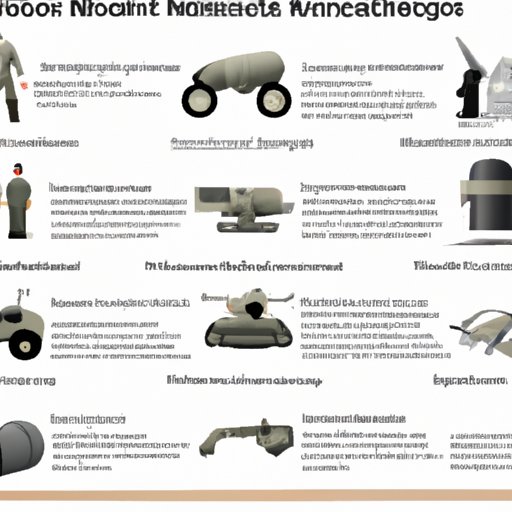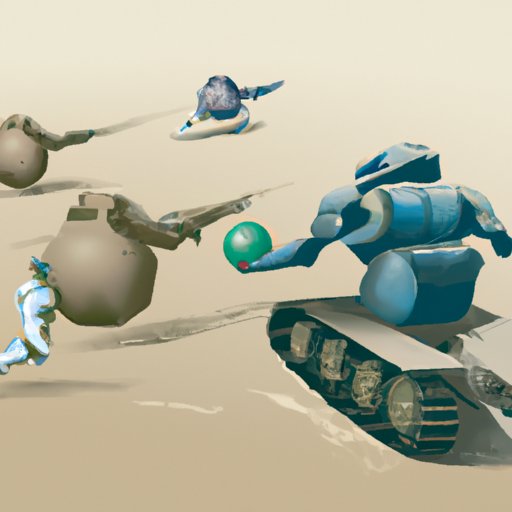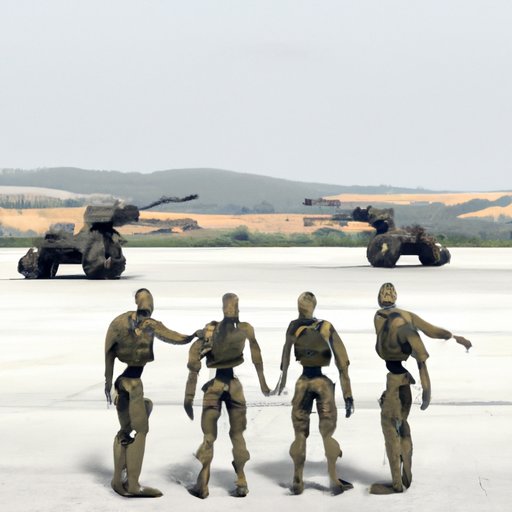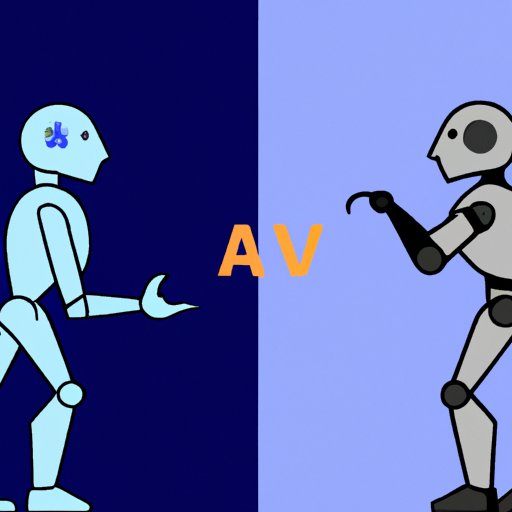Introduction
Robotics has become increasingly prevalent in many aspects of modern life, from manufacturing to healthcare. In recent years, robotics technology has also become an integral part of the military, with robots being used for a variety of applications. This article will explore how robots are used in the military, examining their current and potential future applications, as well as the ethical implications of using them in warfare. Additionally, it will look at how autonomous robots are changing the battlefield and analyze a cost-benefit analysis of utilizing robots in the military.
Definition of Robotics and its Use in the Military
Robotics is defined as the science of designing, constructing, and operating robots. A robot is generally defined as a machine that can perform tasks autonomously or semi-autonomously. The use of robots in the military dates back to the early 20th century, when they were first used for reconnaissance missions. Today, robots are used for a wide range of military applications, including intelligence gathering, surveillance, explosive ordnance disposal (EOD), and even combat.

Overview of Current Military Robot Applications
The most common use of robots in the military today is for intelligence, surveillance, and reconnaissance (ISR) operations. These robots can be deployed on land, sea, or air, and are equipped with advanced sensors and cameras to provide real-time information about the environment. They can be used to monitor enemy movements, detect landmines, and provide real-time images of potential threats. Additionally, robots are often used for search and rescue operations, providing assistance to troops in dangerous situations.
Robots are also increasingly being used for explosive ordnance disposal (EOD). EOD robots are designed to safely dispose of explosives and other hazardous materials, such as chemical and biological weapons. They are equipped with advanced sensors and can be operated remotely, allowing them to navigate hazardous environments without putting human troops at risk.
Finally, unmanned aerial vehicles (UAVs) are becoming increasingly popular for military applications. UAVs are typically equipped with cameras and sensors that allow them to carry out reconnaissance missions and provide real-time intelligence. Additionally, some UAVs are capable of carrying out offensive missions, such as dropping bombs or firing missiles.

Benefits of Utilizing Robots in Combat
There are numerous benefits to utilizing robots in combat, ranging from increased accuracy and precision to improved situational awareness and reduced risk to human troops. According to a study conducted by the National Institute of Standards and Technology, robotic systems can provide “increased accuracy, precision and repeatability” in combat situations, which can help minimize civilian casualties and reduce the risk of collateral damage. Additionally, the study found that robots can provide “improved situational awareness and surveillance capabilities”, allowing troops to make more informed decisions in the heat of battle.
Furthermore, robots can provide increased safety for troops. As stated by Lieutenant Colonel Christopher Woodbridge, a professor at the US Naval War College, “Robots have the potential to save lives by taking humans out of harm’s way and doing dangerous jobs that would otherwise require troops to put themselves in harm’s way.” By using robots in combat, military personnel can avoid putting themselves in dangerous situations, reducing the risk of injury or death.
Examining Current and Potential Future Uses for Military Robots
As previously mentioned, robots are currently being used for a variety of military applications, including intelligence, surveillance, and reconnaissance (ISR) operations, explosive ordnance disposal (EOD), and unmanned aerial vehicles (UAVs). However, there are numerous potential future uses for robots in the military, ranging from search and rescue to medical support.
One potential future application for robots in the military is search and rescue operations. Autonomous robots could be used to search for survivors in hazardous environments, and could even be used to provide medical support to those who have been injured. Additionally, robots could be used for logistics and supply chain management, allowing for more efficient delivery of supplies to troops in the field.
Robots could also be used for reconnaissance missions, as they can be equipped with advanced sensors and cameras that can provide real-time images of potential threats. Additionally, robots could be equipped with artificial intelligence (AI) to enable them to make decisions autonomously, allowing them to respond quickly to changing battlefield conditions.

Investigating Ethical Implications of Using Robots in Warfare
The use of robots in the military raises a number of ethical questions, particularly in regards to moral responsibility and accountability. As noted by Professor Noel Sharkey, a professor at the University of Sheffield, “We need to consider who is responsible if a robot kills an innocent person – the programmer, the operator, the manufacturer, or the government?” Who is accountable for the actions of a robot, and how should they be held responsible?
Additionally, the use of robots in warfare has the potential to further dehumanize war, making it easier for military personnel to disconnect from the consequences of their actions. As noted by Dr. Peter Asaro, a professor at the Graduate Center of the City University of New York, “The use of robots in war removes the psychological barriers to engaging in combat, making it easier for soldiers to kill without feeling guilt or remorse.”
Finally, there is the issue of autonomy and decision-making. Should robots be allowed to make decisions autonomously, or should there be some form of human oversight? If robots are allowed to make decisions autonomously, what safeguards are in place to ensure that they do not make mistakes or cause unnecessary harm?
Discussing How Autonomous Robots Are Changing the Battlefield
Autonomous robots are rapidly transforming the battlefield, as they are able to respond quickly to changing conditions and make decisions without the need for human input. As noted by Dr. Ronald Arkin, a professor at the Georgia Institute of Technology, “Autonomous robots can potentially be programmed to act more ethically on the battlefield than humans, as they are not subject to the same emotions and biases that influence human decision-making.” This could potentially lead to fewer civilian casualties and less collateral damage.
Furthermore, the use of artificial intelligence (AI) is changing the nature of warfare. AI-equipped robots are capable of complex decision-making and can adapt to changing battlefield conditions. Additionally, AI has the potential to revolutionize autonomous weapons systems, allowing them to make decisions autonomously without any human input.
Analyzing Cost-Benefit Analysis of Utilizing Robots in the Military
When considering the use of robots in the military, one must also examine the cost-benefit analysis. While the initial cost of purchasing and maintaining robots may be high, the long-term savings could be significant. For example, robots can reduce the need for human personnel, which can result in cost savings in terms of wages, benefits, and training costs. Additionally, robots can reduce the risk of injury or death to troops, which can lead to lower insurance costs for the military.
Furthermore, robots can increase operational efficiency and reduce downtime, as they can perform certain tasks more quickly and accurately than human personnel. Finally, robots can provide increased accuracy and precision in combat situations, leading to fewer civilian casualties and less collateral damage.
Conclusion
Robotics has become an integral part of the military, with robots being used for a variety of applications, ranging from intelligence gathering to explosive ordnance disposal. There are numerous benefits to utilizing robots in combat, including increased accuracy and precision, improved situational awareness, and reduced risk to human troops. Additionally, robots can provide increased safety for troops and can be used for search and rescue operations. However, there are also a number of ethical considerations that need to be taken into account when using robots in warfare, such as moral responsibility and accountability, and the potential for robots to further dehumanize war.
Finally, a cost-benefit analysis must be conducted when considering the use of robots in the military. While the initial cost of purchasing and maintaining robots may be high, the long-term savings could be significant. Therefore, it is important to weigh the potential benefits and costs of utilizing robots in the military before making a decision.
(Note: Is this article not meeting your expectations? Do you have knowledge or insights to share? Unlock new opportunities and expand your reach by joining our authors team. Click Registration to join us and share your expertise with our readers.)
